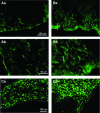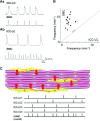Functions of ICC-like cells in the urinary tract and male genital organs
- PMID: 20184664
- PMCID: PMC3828839
- DOI: 10.1111/j.1582-4934.2010.01043.x
Functions of ICC-like cells in the urinary tract and male genital organs
Abstract
Interstitial cells of Cajal (ICC)-like cells (ICC-LCs) have been identified in many regions of the urinary tract and male genital organs by immunohistochemical studies and electron microscopy. ICC-LCs are characterized by their spontaneous electrical and Ca(2+) signalling and the cellular mechanisms of their generation have been extensively investigated. Spontaneous activity in ICC-LCs rises from the release of internally stored Ca(2+) and the opening of Ca(2+)-activated Cl(-) channels to generate spontaneous transient depolarizations (STDs) in a manner not fundamentally dependent on Ca(2+) influx through L-type voltage-dependent Ca(2+) channels. Since urogenital ICC-LCs have been identified by their immunoreactivity to Kit (CD117) antibodies, the often-used specific marker for ICC in the gastrointestinal tract, their functions have been thought likely to be similar. Thus ICC-LCs in the urogenital tract might be expected to act as either electrical pacemaker cells to drive the smooth muscle wall or as intermediaries in neuromuscular transmission. However, present knowledge of the functions of ICC-LCs suggests that their functions are not so predetermined, that their functions may be very region specific, particularly under pathological conditions. In this review, we summarize recent advances in our understanding of the location and function of ICC-LCs in various organs of the urogenital system. We also discuss several unsolved issues regarding the identification, properties and functions of ICC-LCs in various urogenital regions in health and disease.
Figures







Similar articles
-
Properties of spontaneous Ca2+ transients recorded from interstitial cells of Cajal-like cells of the rabbit urethra in situ.J Physiol. 2007 Sep 1;583(Pt 2):505-19. doi: 10.1113/jphysiol.2007.136697. Epub 2007 Jul 5. J Physiol. 2007. PMID: 17615099 Free PMC article.
-
Ca2+ signalling behaviours of intramuscular interstitial cells of Cajal in the murine colon.J Physiol. 2019 Jul;597(14):3587-3617. doi: 10.1113/JP278036. Epub 2019 Jun 13. J Physiol. 2019. PMID: 31124144 Free PMC article.
-
Calcium signalling in Cajal-like interstitial cells of the lower urinary tract.Nat Rev Urol. 2014 Oct;11(10):555-64. doi: 10.1038/nrurol.2014.241. Epub 2014 Sep 16. Nat Rev Urol. 2014. PMID: 25224445 Review.
-
Identification and functional response of interstitial Cajal-like cells from rat mesenteric artery.Cell Tissue Res. 2011 Mar;343(3):509-19. doi: 10.1007/s00441-010-1114-1. Epub 2011 Jan 18. Cell Tissue Res. 2011. PMID: 21243375
-
[Localization and functions of c-kit positive cells in the urinary tract].Folia Med Cracov. 2009;50(3-4):85-93. Folia Med Cracov. 2009. PMID: 21853875 Review. Polish.
Cited by
-
Telocytes' Role in Modulating Gut Motility Function and Development: Medical Hypotheses and Literature Review.Int J Mol Sci. 2022 Jun 24;23(13):7017. doi: 10.3390/ijms23137017. Int J Mol Sci. 2022. PMID: 35806023 Free PMC article. Review.
-
GLI3 repressor controls functional development of the mouse ureter.J Clin Invest. 2011 Mar;121(3):1199-206. doi: 10.1172/JCI45523. Epub 2011 Feb 21. J Clin Invest. 2011. PMID: 21339645 Free PMC article.
-
Identification and classification of interstitial cells in the mouse renal pelvis.J Physiol. 2020 Aug;598(15):3283-3307. doi: 10.1113/JP278888. Epub 2020 Jun 8. J Physiol. 2020. PMID: 32415739 Free PMC article.
-
Telocytes and interstitial cells of Cajal in the biliary system.J Cell Mol Med. 2018 Jul;22(7):3323-3329. doi: 10.1111/jcmm.13643. Epub 2018 Apr 26. J Cell Mol Med. 2018. PMID: 29700981 Free PMC article. Review.
-
Pathophysiological Implications of Interstitial Cajal-like Cells (ICC-like) in Uterus: A Comparative Study with Gastrointestinal ICCs.Curr Issues Mol Biol. 2023 Sep 15;45(9):7557-7571. doi: 10.3390/cimb45090476. Curr Issues Mol Biol. 2023. PMID: 37754260 Free PMC article. Review.
References
-
- Sanders KM, Koh SD, Ward SM. Interstitial cells of Cajal as pacemakers in the gastrointestinal tract. Annu Rev Physiol. 2006;68:307–43. - PubMed
-
- Brading AF, McCloskey KD. Mechanisms of disease: specialized interstitial cells of the urinary tract–an assessment of current knowledge. Nat Clin Pract Urol. 2005;2:546–54. - PubMed
Publication types
MeSH terms
LinkOut - more resources
Full Text Sources
Miscellaneous

